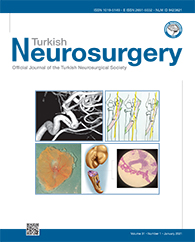2University of Health Sciences, Gulhane Faculty of Medicine, Affiliated Hospital of Ankara Health and Practice Center, Department of Neurosurgery, Ankara, Turkey
3Lokman Hekim University, Faculty of Medicine, Department of Anatomy, Ankara, Turkey DOI : 10.5137/1019-5149.JTN.29202-20.3 AIM: To examine the effect of propolis on the healing process in terms of both electrophysiological and ultrastructural parameters in a rat model of experimental spinal cord injury.
MATERIAL and METHODS: Thirty rats were divided into control, spinal cord trauma, and treated trauma groups with 10 rats per group. The rats were sacrificed after 10 days. Before sacrifice, all rats were neurologically assessed by electrophysiological monitoring, and immediately after sacrifice, the spinal cord was examined ultrastructurally by transmission electron microscopy (TEM).
RESULTS: According to the electrophysiological examination, the treatment group was statistically significantly different from the trauma group. However, no statistically significant difference was found between the control and treatment groups. In terms of the TEM examination, the treatment group was significantly different from the trauma group.
CONCLUSION: In this study, propolis was administered just before the induction of trauma, and the findings suggest that the use of propolis has a positive effect on the healing process. This implies that in order to prevent postoperative deficits, this treatment may be preferably applied before spinal cord surgery for trauma.
Keywords : Spinal cord injury, Propolis, Electron microscopy, Ultrastructure




